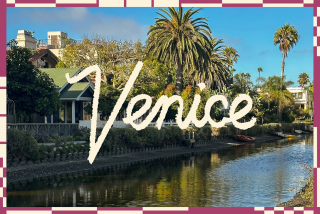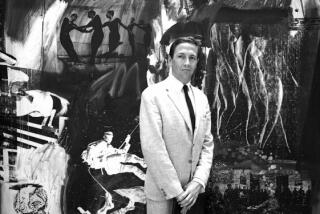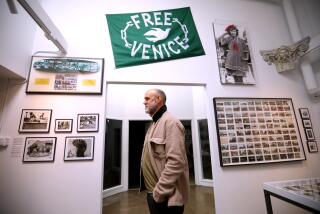The Waters Where Cultures Converged
- Share via
If you had wandered the streets of Venice, Italy, in about the year 1000, you would have stumbled onto a city brimming with the confidence that money brings, a vast trading port, its merchants contentedly counting gold reaped from Greek, Arab and Byzantine coffers. But the city’s newfound luxury masked a city founded on fear. Venice’s first inhabitants came to these muddy islands reluctantly--5th century refugees from an invasion of marauding Goths. Only after another century’s worth of subsequent attacks did they decide to stay, tired of being trampled under the hooves of mounted barbarian armies. Who else but the desperate, after all, would build a city on mud, sand and water?
The most extraordinary visions, however, sometimes rise out of the most unlikely contexts. And there is something peculiar about the Venetian landscape that suggests the beginnings of a truly unique urban pattern, absurdly irrational but also remarkably beautiful. This is a slippery city, balanced between land and sea, East and West, the ephemeral and the real.
It begins with the instability of the earth underfoot. As the city swelled, a series of doges fortified the islands, draining the flat, muddy surfaces, buttressing the shores to protect the city from the sea. But despite their best efforts, Venice’s marshes offered little structural support for the ambitious builder.
The result was the construction of structures of exquisite lightness, begun around the time of the millennium. Typically, the low two-story houses that lined the canals were made of lightweight wood. Occasionally, richer merchants built more imposing brick homes that rested on massive porticoes--entry portals to the large storerooms where the boats that navigate the city’s congested canals could unload their goods. Perched at the water’s edge, these buildings evoked the double-edged nature of the city. Both commercial enterprises and living places, their main entries opened onto the water, their backs onto the firmer ground of the alleyways.
Scattered among this urban infill were various brick and stone structures that were beginning to give the city some architectural weight. Buildings such as the Agnello palace, built by the 9th century doge who fortified much of the city’s foundations, or the church of San Giacomo di Rialto rested on thousands of wooden piles, which were densely packed and pounded deep into the muck. The effect was a dreamlike city whose most imposing structures seemed to float above the sad, muddy sea that laps its shores.
All of that geological unease was coupled with the extraordinary cultural complexity of a city that embodies the religious schism between Rome and Constantinople, because if Venice’s roots are in the West, its cultural alliance is with Constantinople and the East. Look at its churches closely and you glean a hybrid of Byzantine styles and Roman construction techniques, an assemblage of Greek Cross or Basilican plans and brick masonry.
Nowhere are these tensions more palpable than in the (original) Basilica of St. Mark, at the city’s symbolic heart. Modeled on a Greek Cross plan, the original Basilica’s bulbous dome reinforced the city’s cultural ties with Constantinople. But the surrounding square subtly reasserted the city’s schizophrenic nature: A covered dock separated the Basilica--the seat of the church’s power--from the fortress-like doge’s palace--the seat of political power. And the main piazza fronting the Basilica was divided by a narrow canal--the Rio Batario--which cut it off from the smaller church of the facing San Geminiano. Together, these three sections seemed to sum up the fragility of the city’s urban identity.
What Venice still awaited, of course, was an urban visionary with the ability to identify what made this city so unique, and with the will to pull it all together into an imaginative urban whole. Few cities--even those like Genoa and Padua, whose economies are similarly trade-based--embody such a variety of conflicting traditions. No other has Venice’s peculiar watery urban landscape. Civic leaders may have scoffed. Too costly. Too unconventional. But only the rarest cities evolve into living works of art, expanding the boundaries of the human imagination.
*
The evolution of Venice into the world’s most remarkable urban dreamscape continued with the construction of the current Basilica in 1063 and would drag on over centuries. Modeled on Byzantine churches, the new Basilica’s form is capped by five bulbous domes that remain the city’s most recognizable architectural feature. Soon after, Sebastiano Ziani, the city’s first elected doge, would begin to fuse the city into a unified urban whole. The present St. Mark’s Square, among the world’s great public spaces, was finally completed by Napoleon I in the early 19th century.
More to Read
The biggest entertainment stories
Get our big stories about Hollywood, film, television, music, arts, culture and more right in your inbox as soon as they publish.
You may occasionally receive promotional content from the Los Angeles Times.










